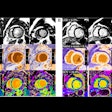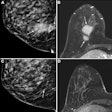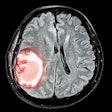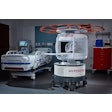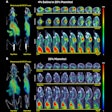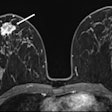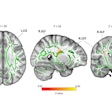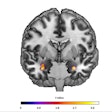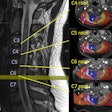Although the routine clinical use of 7-tesla MRI may be several years away, researchers at Vanderbilt University have begun testing implants and other items to determine how they will react when exposed to an ultrahigh-field magnet, according to a study published in the February issue of the American Journal of Roentgenology.
Research instructor and biomedical engineer Adrienne Dula, PhD, is leading a group that has tested 28 implantable items, including aneurysm clips, vascular and orthopedic implants, breast biopsy tissue markers, and a hemostatic clip. So far, Dula and colleagues have found eight implantable devices that pose a risk to patients.
"All of the nonmagnetic material seems to be fine at 7 tesla," Dula told AuntMinnie.com. "There were a few things that were not safe at 7 tesla but are safe at 3 tesla. That is what we expected, given the higher field strength and different physical environment."
What did surprise the researchers were results from heating experiments conducted on two metal nonferromagnetic aneurysm clips. While the clips exhibited some heating, the increase in temperature did not exceed 1° C (AJR, February 2014, Vol. 202:2, pp. 401-405).
"We expected that if you put a metal aneurysm clip inside of the [radiofrequency] field, it would significantly heat up, but based on our studies, we did not see any significant heating," she said. "Based on that, the aneurysm clips seem to be safe at 7 tesla."
7-tesla safety
Currently, no patient with a known metallic implant is allowed to undergo a 7-tesla MRI scan. This means that many patients with certain conditions who may benefit from the detailed resolution of ultrahigh-field MRI are excluded, the study authors noted.
Vanderbilt has been using its 7-tesla MRI system for research purposes, such as testing protocols, developing sequences, exploring processing methods, and investigating the modality's potential for brain and breast cancer, multiple sclerosis, Parkinson's disease, and other conditions.
"But we are running into a lot of obstacles when we try to bring in patients who have had previous surgeries or have implants or devices that are OK at 3 tesla and in clinical scanners, but no safety testing has been done on those biomedical implants at 7 tesla," Dula said.
The study measured each object in terms of translational attraction and torque using Vanderbilt's 7-tesla system (Achieva, Philips Healthcare). Measurement devices gauged the strength of the 7-tesla magnet, and phantoms with temperature probes were used to assess any temperature increases.
The center of an MRI system is the point at which the magnetic pull is strongest, Dula explained. As an object moves away from the center, field strength decreases. Based on the configuration of an MRI scanner, the magnetic force can decrease quickly as distance from the scanner's center increases.
"When you have something that is ferromagnetic within that [magnetic] field, it is going to be pulled closer and closer to the highest field strength in the center of the scanner," she said. "So, if you have an aneurysm clip within the field, it will be pulled at an accelerating speed and greater force as the change in magnetic field experienced increases. That is known as the translational attraction or the 'missile effect.' "
MRI vs. gravity
To measure translational attraction, the researchers suspended each item from a string and measured the deflection angle, which reflects the strength of the scanner's force. The greater the deflection angle, the greater the force an object is experiencing as it is pulled toward the scanner.
For example, the hemostatic clip tested in the study had a deflection angle of 90°, so it was pulled very strongly into the 7-tesla scanner's bore. By comparison, the aneurysm clips in the study only had deflection angles of 7° to 49°, so these objects experienced less force.
The deflection angle benchmark for MRI at any magnet strength is 45°, which is equal to the force of gravity.
"That 45° is not an arbitrary angle," Dula said. "It indicates the point at which the force from the 7-tesla scanner outweighs the force of gravity. So there is a greater force on the object from the scanner than gravity."
"Thus, deflection angle results above 45° have potential safety implications for metallic objects exposed to the 7T MRI environment," the researchers wrote in their paper.
The deflection angles in the current study ranged from 1° to 49° for the vascular implants, 0° to 55° for the orthopedic implants, 0° to 18° for the biopsy tissue markers, and 70° to 90° for the miscellaneous objects (a vascular access port and a bullet).
| Biomedical implants and objects | ||
| Name | Vendor | Deflection angle |
| Yasargil FE 863 K aneurysm clip | Aesculap | 49° |
| Resolution hemostatic clip | Boston Scientific | 90° |
| VenaTech LP vascular implant | B. Braun | 49° |
| VenaTech LGM vascular implant | B. Braun | 48° |
| Synergy orthopedic hip implant | Smith & Nephew | 55° |
| Summit Hip Stem implant | Smith & Nephew | 45° |
| Port-A-Cath vascular access port | SIMS Deltec | 70° |
| Armor-piercing full metal jacket (FMJ) bullet | Norinco | 90° |
Depending on the implant, patients might feel the device pulling inside of them as they get closer to the scanner, similar to how oxygen tanks or floor buffers have been pulled into MRI systems in past accidents.
"We can't let those kinds of things even in the vicinity of the scanner," Dula said. "So it is very important to know which [implants] will experience this type of 'missile effect' the closer they come to the scanner."
Feeling the heat
Because the 7-tesla MRI system does not have a radiofrequency (RF) body coil, heating and artifacts are "not a concern for metallic objects present outside the head," the authors wrote. Therefore, the group only temperature-tested the two aneurysm clips that would be located within a head RF coil during a 7-tesla MRI scan.
The rise in temperature of the two clips did not exceed 1° C, which the researchers said was an acceptable level.
"However, once a transmit body radiofrequency coil or other type of anatomy-specific radiofrequency coil becomes available for 7T MR systems, it will be necessary to repeat the MRI-related heating test for the implants and other objects that would be subjected to radiofrequency energy to ensure the safety of MRI examinations of patients with those items," they wrote.
To determine the torque of the objects, the researchers rotated each device in 45° increments through a full 360° turn to observe its movement. A ferromagnetic object will align with the magnetic field similar to the way a compass always points north. The group used a five-point qualitative scale to measure torque, with 0 indicating no torque and 4 representing very strong torque, with the object rapidly and forcefully aligning with the magnetic field.
Objects with high translational attraction also had high torque ratings, the researchers found. Qualitative torque measurements were 0 to 4 for the aneurysm clips, 4 for the hemostatic clip, 0 to 3 for the vascular implants, 0 to 2 for the orthopedic implants, 0 to 1 for the biopsy markers, and 3 to 4 for the miscellaneous objects.
The Vanderbilt group has been adding to its stash of implantable devices to test, taking in another 30 contributions from various departments, including orthopedics and dermatology, as well as the Vanderbilt Eye Institute. Several additional orthopedic implants tested as safe at both 7 tesla and 3 tesla, Dula said.
"I think it is very important for us to have a very wide catalog of implants because not every surgeon uses the same brand," she added. "We want to include everybody we can in the 7-tesla studies so they have confidence that they are going to be safe when they go in the scanner."


.fFmgij6Hin.png?auto=compress%2Cformat&fit=crop&h=100&q=70&w=100)




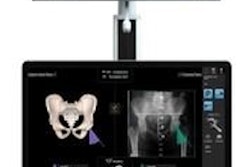
.fFmgij6Hin.png?auto=compress%2Cformat&fit=crop&h=167&q=70&w=250)
